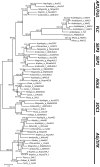Prevalent Exon-Intron Structural Changes in the APETALA1/FRUITFULL, SEPALLATA, AGAMOUS-LIKE6, and FLOWERING LOCUS C MADS-Box Gene Subfamilies Provide New Insights into Their Evolution
- PMID: 27200066
- PMCID: PMC4852290
- DOI: 10.3389/fpls.2016.00598
Prevalent Exon-Intron Structural Changes in the APETALA1/FRUITFULL, SEPALLATA, AGAMOUS-LIKE6, and FLOWERING LOCUS C MADS-Box Gene Subfamilies Provide New Insights into Their Evolution
Abstract
AP1/FUL, SEP, AGL6, and FLC subfamily genes play important roles in flower development. The phylogenetic relationships among them, however, have been controversial, which impedes our understanding of the origin and functional divergence of these genes. One possible reason for the controversy may be the problems caused by changes in the exon-intron structure of genes, which, according to recent studies, may generate non-homologous sites and hamper the homology-based sequence alignment. In this study, we first performed exon-by-exon alignments of these and three outgroup subfamilies (SOC1, AG, and STK). Phylogenetic trees reconstructed based on these matrices show improved resolution and better congruence with species phylogeny. In the context of these phylogenies, we traced evolutionary changes of exon-intron structures in each subfamily. We found that structural changes have occurred frequently following gene duplication and speciation events. Notably, exons 7 and 8 (if present) suffered more structural changes than others. With the knowledge of exon-intron structural changes, we generated more reasonable alignments containing all the focal subfamilies. The resulting trees showed that the SEP subfamily is sister to the monophyletic group formed by AP1/FUL and FLC subfamily genes and that the AGL6 subfamily forms a sister group to the three abovementioned subfamilies. Based on this topology, we inferred the evolutionary history of exon-intron structural changes among different subfamilies. Particularly, we found that the eighth exon originated before the divergence of AP1/FUL, FLC, SEP, and AGL6 subfamilies and degenerated in the ancestral FLC-like gene. These results provide new insights into the origin and evolution of the AP1/FUL, FLC, SEP, and AGL6 subfamilies.
Keywords: AGAMOUS-LIKE6; APETALA1/FRUITFULL; FLOWERING LOCUS C; SEPALLATA; exon-intron structural change.
Figures






Similar articles
-
Functional and evolutionary analysis of the AP1/SEP/AGL6 superclade of MADS-box genes in the basal eudicot Epimedium sagittatum.Ann Bot. 2014 Mar;113(4):653-68. doi: 10.1093/aob/mct301. Epub 2014 Feb 13. Ann Bot. 2014. PMID: 24532606 Free PMC article.
-
Origination and selection of ABCDE and AGL6 subfamily MADS-box genes in gymnosperms and angiosperms.Biol Res. 2019 Apr 24;52(1):25. doi: 10.1186/s40659-019-0233-8. Biol Res. 2019. PMID: 31018872 Free PMC article.
-
Conservation and divergence of ancestral AGAMOUS/SEEDSTICK subfamily genes from the basal angiosperm Magnolia wufengensis.Tree Physiol. 2020 Jan 1;40(1):90-107. doi: 10.1093/treephys/tpz091. Tree Physiol. 2020. PMID: 31553477
-
Flower development: the evolutionary history and functions of the AGL6 subfamily MADS-box genes.J Exp Bot. 2016 Mar;67(6):1625-38. doi: 10.1093/jxb/erw046. J Exp Bot. 2016. PMID: 26956504 Review.
-
The major clades of MADS-box genes and their role in the development and evolution of flowering plants.Mol Phylogenet Evol. 2003 Dec;29(3):464-89. doi: 10.1016/s1055-7903(03)00207-0. Mol Phylogenet Evol. 2003. PMID: 14615187 Review.
Cited by
-
Divergent Functional Diversification Patterns in the SEP/AGL6/AP1 MADS-Box Transcription Factor Superclade.Plant Cell. 2019 Dec;31(12):3033-3056. doi: 10.1105/tpc.19.00162. Epub 2019 Oct 7. Plant Cell. 2019. PMID: 31591161 Free PMC article.
-
The Origin of Floral Organ Identity Quartets.Plant Cell. 2017 Feb;29(2):229-242. doi: 10.1105/tpc.16.00366. Epub 2017 Jan 18. Plant Cell. 2017. PMID: 28100708 Free PMC article.
-
Diversification of ranunculaceous petals in shape supports a generalized model for plant lateral organ morphogenesis and evolution.Sci Adv. 2023 Apr 21;9(16):eadf8049. doi: 10.1126/sciadv.adf8049. Epub 2023 Apr 21. Sci Adv. 2023. PMID: 37083529 Free PMC article.
-
Phylogenomic Synteny Network Analysis of MADS-Box Transcription Factor Genes Reveals Lineage-Specific Transpositions, Ancient Tandem Duplications, and Deep Positional Conservation.Plant Cell. 2017 Jun;29(6):1278-1292. doi: 10.1105/tpc.17.00312. Epub 2017 Jun 5. Plant Cell. 2017. PMID: 28584165 Free PMC article.
-
Morphological and molecular mechanisms of floral nectary development in Chinese Jujube.BMC Plant Biol. 2024 Nov 4;24(1):1041. doi: 10.1186/s12870-024-05760-8. BMC Plant Biol. 2024. PMID: 39497044 Free PMC article.
References
LinkOut - more resources
Full Text Sources
Other Literature Sources

